|
faytech 15" Touch PC
IP65-sealed, fanless, high-bright, industrial-grade capacitive Touch PC
(by Conrad H. Blickenstorfer)
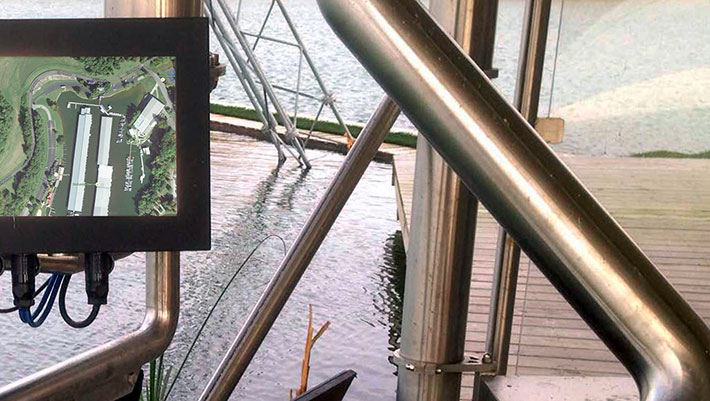
This article began as a standard review of an industrial panel computer, faytech's 15-inch, IP65-sealed capacitive touch PC. Panel PCs are designed to bring computing to all sorts of places where a regular desktop or notebook computer isn't feasible or just won't do. Panel PCs are usually configured as robust, plain boxes with display sizes ranging from very small to quite large. They are used in places like factories, warehouses, distribution and control centers, terminals and other demanding environments that are hard on equipment, yet demand superior reliability and often 24/7/365 uptime to boot.
While most Panel PCs are conceptually the same, they come in a remarkable variety of sizes, capabilities, and performance. Some have displays as little as 5 inches diagonally, others are as big as a giant flat screen TV. Some do little more than display menu systems and therefore don't need much computing power while others may perform complex tasks requiring high performance and advanced connectivity.
Panel PC technology isn't very exciting in terms of numbers, glitz and glamor. Unless, of course, you're an engineer with an eye for rational design, elegant solutions, and rock-solid functionality. What is exciting, however, is the way panel PCs are being used. They make amazing things possible.
And at least in the case of faytech, there's an amazing story behind the company that makes the boxy, industrial PCs that make those amazing things possible.
See, faytech is not your typical tech company. They got started a decade and a half ago by Arne Weber, a young German tech geek who initially dabbled in various consumer technologies, but then began specializing in importing and distributing industrial touchscreen panels.  Increasingly finding themselves in competition with their suppliers and seeking higher degrees of quality control, faytech established their own brand. Increasingly finding themselves in competition with their suppliers and seeking higher degrees of quality control, faytech established their own brand.
In 2008, Weber and his Chinese-born wife Fan Yang moved to Shenzen, China, initially to work more closely with their suppliers on quality control.
Eventually the couple decided to set up their own production facility in Shenzen. In the process, they built a comprehensive quality control and problem analysis system designed to root out all defects.
Today, faytech prides itself in merging German-style quality control and engineering with Chinese manufacturing efficiency and economy. As Weber explains, this results in faytech having a product quality advantage in low-cost markets and a product price advantage in high-cost markets. Weber also emphasizes faytech's close working relationship with their customers in creating products and solutions that exactly fill their needs. Such taylor-made solutions have become a strength of the company, often giving them an edge over larger competitors whose fixed product lines may require applications and processes adapt to the features and limitations of the hardware.
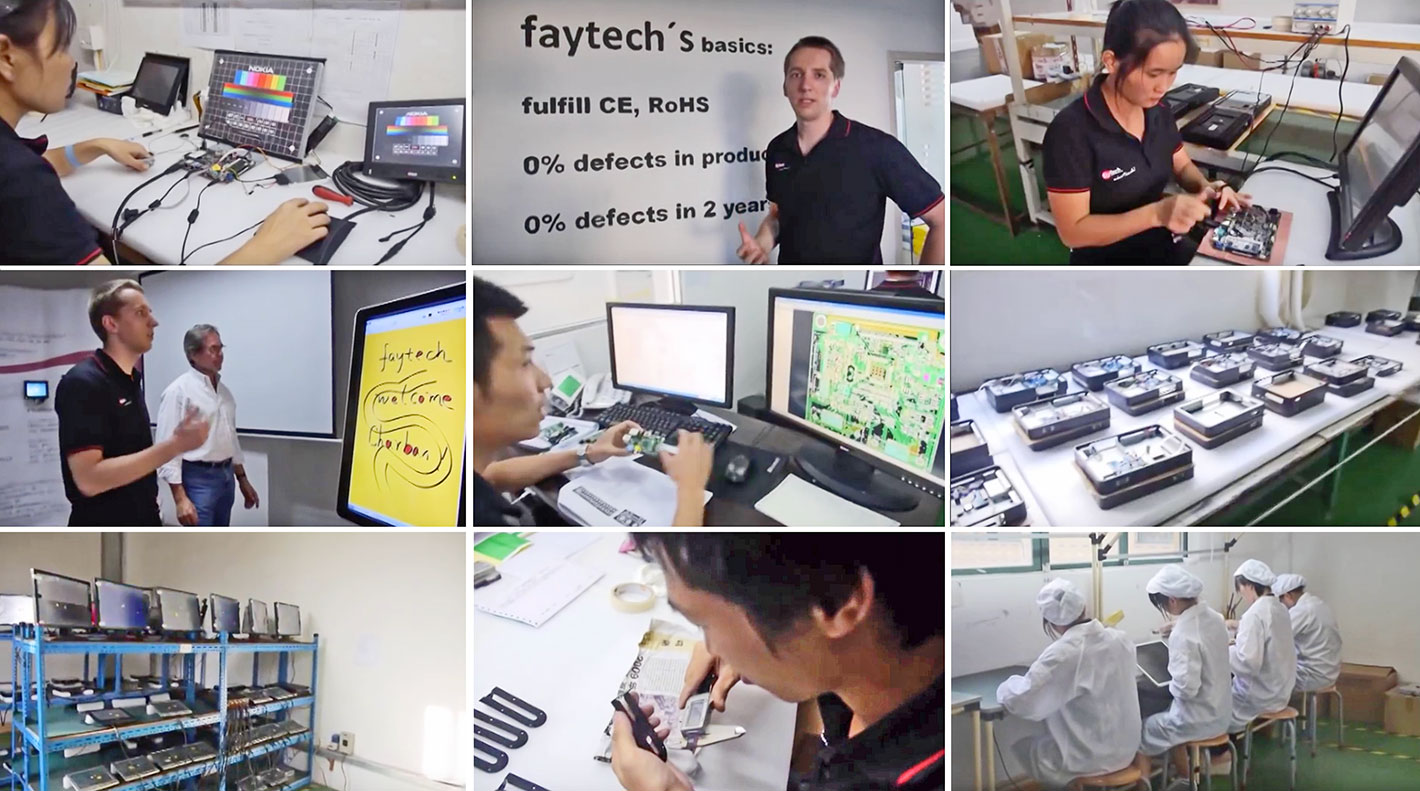
While observing the market imperatives of design longevity and both legacy and state-of-the-art connectivity support, Weber and Yang are firm believers in adapting and integrating ancillary and complementary technologies whenever and wherever it makes sense and they see an opportunity.
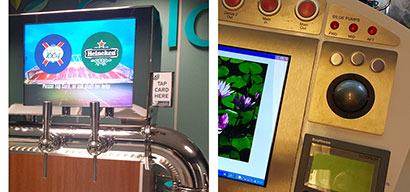 Though always on the lookout for novel, productivity-enhancing solutions no one has thought of before, Weber also sees numerous legacy applications where older mechanical or push-button control systems are in dire need of replacement with intelligent touchscreen systems with processing power suited for comprehensive, advanced solutions. Though always on the lookout for novel, productivity-enhancing solutions no one has thought of before, Weber also sees numerous legacy applications where older mechanical or push-button control systems are in dire need of replacement with intelligent touchscreen systems with processing power suited for comprehensive, advanced solutions.
Faytech has customers in hospitality, food services, law enforcement, first responders, car washes, healthcare, factory automation, machine steering, exercise machine, public transportation, and many more.
Weber gives customers a lot of credit. "They are more creative than we ever imagined!" he says, showing off some of their installations that integrate face recognition, 3D scanners, printers, ID and RFID readers, and so on.
By 2013, faytech had its own 15,000 sqft operation in the Hongmen Technology Park, in Shenzhen and they were awarded ISO 9001:2008 certification. This year faytech moved to a new 37,000 sqft facility with over 150 staff and significant new investment in optical bonding and other advanced technology.
15-inch capacitive IP65 high-bright touch PC
Compared to most embedded systems manufacturers, faytech's product lineup is remarkably focussed. They make resistive and capacitive touch monitors and PCs with various types of enclosures, and displays ranging in size from 7 to 55 inches diagonally. This whole gamut of systems is either powered by an Intel-based fay-002 series motherboard using the 165 x 115 mm EPIC form factor, or an embedded ARM-based board.
The 15-inch review unit the company sent us is part of their IP65 High Brightness line of capacitive touch PCs designed primarily for demanding industrial outdoor applications. The housing is made of heavy gauge aluminum so as to be virtually immune to abuse. There are no physical controls on the front panel. The display is very bright, and IP65 ingress protection means it's totally sealed against dust and can also handle low-pressure water jets from all directions. Below you can see what the panel looks like from the front and from all four sides:
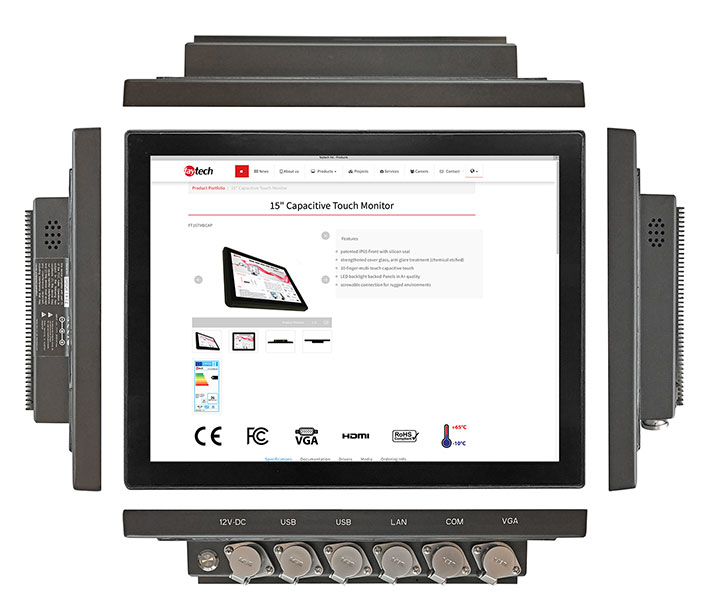
Thanks to its fairly narrow bezel area, the panel has a compact footprint of 14.5 x 11.3 inches and the display box is only about three quarters of an inch thick. The system box measures about 11.5 x 7.5 inches and is about 1.7 inches thick. Although it feels as solid and substantial as can be, the panel actually weighs no more than about 7.5 pounds.
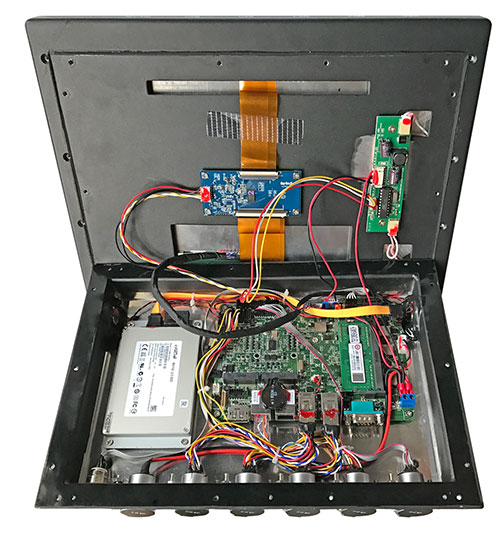 Unlike many industrial panel computers where just the front panel is protected against dust and liquids (because they are usually mounted on a panel where the backside is not exposed), this faytech design is fully sealed. That's also clearly evident from the types of connectors faytech uses. Each has a spring-loaded cap with an o-ring seal. Inside, each of the wires of every port is individually sealed. Unlike many industrial panel computers where just the front panel is protected against dust and liquids (because they are usually mounted on a panel where the backside is not exposed), this faytech design is fully sealed. That's also clearly evident from the types of connectors faytech uses. Each has a spring-loaded cap with an o-ring seal. Inside, each of the wires of every port is individually sealed.
The faytech 15-inch touch PC, like most industrial Box PCs, employs a simple and straight-forward design. It consists of two open aluminum boxes, the shallow front one to accommodate the LCD display, the deeper rear one to hold the electronics. There is a simple rubber pressure seal between the front and the rear, the two halves are secured to each other via 14 small Philips screws, and just for good measure, black silicone sealer is applied around the entire perimeter where the two halves meet.
Needless to say, we had to take a look inside where the unit's fay-002 motherboard lives. That did require cutting the silicone seal. given the thick pressure seal between the halves, the extra silicone doesn't appear to be essential, but we'd advise customers to replace it upon reassembly.
Unlike a lot of gear we disassemble and examine, the faytech panel has no secrets and nothing's hidden. There's the fay-002 motherboard, there's the solid state disk, and there's the PC-style wiring. Solid, functional, not flimsy. It's like looking under the hood of a classic Mercedes Benz. Solid, solid, solid to the max.
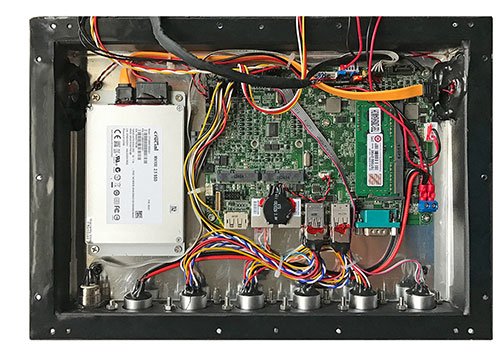 Since faytech is using their fay-002 motherboard in most of their panel PCs, the board has just about any type of interface customers might need or want. Not everything, however, is connected in every faytech panel. That depends on the model, the application, and what the customer needs. Since faytech is using their fay-002 motherboard in most of their panel PCs, the board has just about any type of interface customers might need or want. Not everything, however, is connected in every faytech panel. That depends on the model, the application, and what the customer needs.
Our review panel offered the following rugged external ports:
- Power (8 to 36 Volt DC)
- 2 x USB
- 1 x LAN
- 1 x COM
- 1 x VGA
Each of these rugged connectors needs its on adapter cable, and some ports support multiple connections.
The adapter cables that came with our tester thus offered a total of three USB 2.0 ports, one USB 3.0 port, two RS232 serial ports, two RJ45 gigabit LAN ports, and one VGA port. In addition to the external connectivity wired on our unit, the fay-002 motherboard itself also supports another VGA port, DisplayPort, LVDS, S/PDIF, audio in/out, an audio amplifier, PS/2, and 8-bit Digital I/O. Additional expansion is provided by two mini PCIe card slots.
For RAM, the fay-002 has a single SO-DIMM RAM slot, populated in our unit with a 4GB DDR3L 1333 module. For mass storage, our unit came with a 128GB Crucial MX100 2.5-inch solid state drive. There's also a second SATA 3GB/s port.
The unit's operating temperature range is a very wide 14°F to 140°F (-10°C to 60°C). It can be used almost anywhere.
Performance
Now what about performance? What sort of a processor should a Panel PC like the faytech Touch PC have? There's no easy answer. While most consumer PCs benefit from having as much performance as possible to run full-size, full-service operating systems, all sorts of applications, games, multi-media, and streaming video, most industrial panels have predictable loads and are used for comparatively simple dedicated custom applications that rarely change, and have well-known resource requirements. Since that's the case, it doesn't make sense to provide more performance (read cost and cooling) than needed. The device, of course, must get the job done, reliably, and get it done well, but anything beyond that would be an expensive luxury.
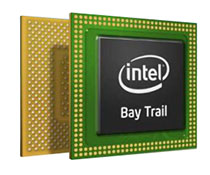 To meet that challenge, faytech selected the Intel Celeron J1900 processor as the go-to chip for their capacitive touch devices. The J1900 is part of Intel's large "Bay Trail" family of CPUs that includes Atom, Celeron and Pentium branded chips. Intel traditionally used the Celeron brand largely for entry level processors, and the "Pentium" brand for high-end chips. Today, the high end is Core processors, and lower level processors may carry the Atom, Celeron or Pentium brand names. "Bay Trail" chips are based on a heavily overhauled Intel Atom architecture and include graphics that use the same Intel execution units (EUs) as Intel's 3rd generation Core processors. This gives them support for most of the same APIs and features as the much more expensive Core processors. There's USB 3.0, 22nm lithography, and the 64-bit instruction set. And DirectX 11, OpenGL 3.X, and OpenCL 1.2 are all present on the API side. To meet that challenge, faytech selected the Intel Celeron J1900 processor as the go-to chip for their capacitive touch devices. The J1900 is part of Intel's large "Bay Trail" family of CPUs that includes Atom, Celeron and Pentium branded chips. Intel traditionally used the Celeron brand largely for entry level processors, and the "Pentium" brand for high-end chips. Today, the high end is Core processors, and lower level processors may carry the Atom, Celeron or Pentium brand names. "Bay Trail" chips are based on a heavily overhauled Intel Atom architecture and include graphics that use the same Intel execution units (EUs) as Intel's 3rd generation Core processors. This gives them support for most of the same APIs and features as the much more expensive Core processors. There's USB 3.0, 22nm lithography, and the 64-bit instruction set. And DirectX 11, OpenGL 3.X, and OpenCL 1.2 are all present on the API side.
What that means is that the quad-core Atom J1900 processor powering faytech's capacitive touch panel PCs packs far more punch than earlier chips in fanless packages, even though its thermal design power is just 10 watts, less than that of even ultra-low voltage mobile Intel Core processors. In fact, in a August 2015 technology blog article entitled "Replacing the Atom N2600," we concluded that "the Celeron J1900 seems to have all the goods to be a solid, remarkably speedy, yet still economical go-to chip for any number of industrial computing projects where absolutely minimal power consumption is not the highest priority."
To provide an idea of the relative performance of faytech's J1900-powered 15-inch touch PC, we ran our two standard benchmark suites, PassMark and CrystalMark. For comparison, we're also listing the results of three other panel systems we've we've tested at RuggedPCReview. We're providing this comparison simply to show the relative performance levels of different processor classes in such systems.
|
faytech 15-inch touch PC Benchmarks and Comparisons
|
|
PERFORMANCE COMPARISON
|
faytech
|
Advantech
|
Advantech
|
Logic Supply
|
|
Model
|
15" Touch PC
|
UTC-515
|
PPC-6170
|
Cincoze Crystal 15
|
|
Model (click pic for review)
|

|

|

|

|
|
Type
|
Industrial Panel PC
|
Industrial Panel PC
|
Industrial Panel PC
|
Industrial Panel PC
|
|
Year tested
|
2016
|
2012
|
2014
|
2015
|
|
Intel processor
|
Celeron J1900
|
Atom D510
|
Core i5-3610ME
|
Atom E3845
|
|
Cores/threads
|
4/4
|
2/4
|
2/4
|
4/4
|
|
CPU base speed
|
2.00GHz
|
1.66GHz
|
2.70GHz
|
1.91GHz
|
|
CPU turbo speed
|
2.42GHz
|
no turbo
|
3.3GHz
|
no turbo
|
|
Thermal Design Power (TDP)
|
10 watts
|
13 watts
|
35 watts
|
10 watts
|
|
CPU Mark
|
2,430.0
|
512.4
|
2,816.4
|
1,951.3
|
|
2D Graphics Mark
|
209.9
|
153.8
|
429.0
|
149.0
|
|
Memory Mark
|
538.0
|
235.6
|
927.4
|
410.3
|
|
Disk Mark
|
2,261.9
|
261.1
|
291.3
|
1,417.4
|
|
3D Graphics Mark
|
139.2
|
12.1
|
291.2
|
134.4
|
|
Overall PassMark
|
1,251.4
|
256.0
|
1,080.7
|
921.3
|
|
CM ALU
|
32,093
|
10,772
|
49,581
|
25,575
|
|
CM FPU
|
27,711
|
9,663
|
47,402
|
21,647
|
|
CM MEM
|
21,125
|
7,709
|
29,696
|
20,400
|
|
CM HDD
|
35,405
|
7,357
|
7,065
|
31,856
|
|
CM GDI
|
6,612
|
2,592
|
13,496
|
4,856
|
|
CM D2D
|
4,580
|
3,685
|
2,643
|
3,654
|
|
CM OGL
|
4,117
|
723
|
7,482
|
3,311
|
|
Overall CrystalMark
|
131,645
|
42,501
|
157,365
|
111,299
|
What the results reveal:
- First, the quad-core Atom J1900 chip faytech picked as one of two CPU options (the other is the lower performance Atom N2807) for their fay-002 is a very respectable performer. Although still based on an Atom processor architecture, the J1900 provides is much quicker than any older Atom-based systems. Compared to the Atom D510 widely used in industrial systems just four or five years ago, the J1900 offers 5x CPU performance.
- Second, even compared against other popular "Bay Trail" Atom processors such as the quad-core E3845 we've often seen in rugged tablets, the J1900 is quicker by a good margin.
- Third, Intel Core processors are generally in an entirely different performance (and price!) league than Atom-based chips. But even compared to a 3rd generation Core based Advantech panel we tested a couple of years ago, the J1900-based faytech touch PC (aided by a much faster SSD) looks quite good.
- And fourth, just as a general observation, do note the huge performance difference between rotating and solid state disks. Always keep that in mind. Disk can make a bigger overall speed difference than the processor.
The faytech 15-inch capacitive IP65 high-bright touch PC
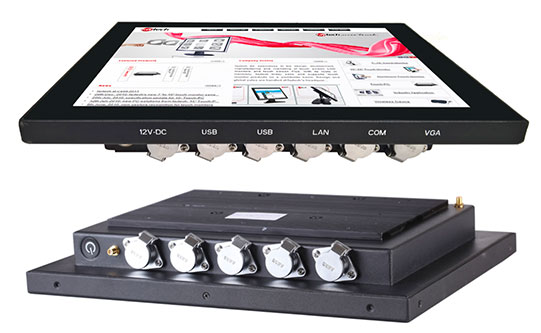 faytech's goal is to provide German quality and organization at pricing made possible through manufacturing in China. And since the German management team actual is located in China, that's more than just marketing speak. faytech's goal is to provide German quality and organization at pricing made possible through manufacturing in China. And since the German management team actual is located in China, that's more than just marketing speak.
Concentrating exclusively on industrial touch monitors and touch PCs, faytech is very focussed and committed to their niche, and able to provide innovative customized solutions.
The company's decision to base all of their panel products on a small number of highly configurable multi-purpose single board computers minimizes errors and incompatibilities.
With meticulous build quality, a large range of display sizes, availability of different touch technologies, different levels of ruggedness, inter-compatible electronics, and eagerness to work with customers on novel uses and applications, faytech's approach is both impressive and refreshing.
-- Conrad H. Blickenstorfer, November 2016
faytech 15-inch IP65 Touch PC Specs:
| Status |
Added and reviewed 11/2016
|
| Type |
Industrial capacitive touch Panel PC
|
| CPU Type |
Quad-core Intel "Bay Trail" Celeron J1900 w/ 2MB L2 cache
|
| CPU base speed |
2.00 GHz
|
| CPU burst frequency |
2.42 GHz
|
| OS |
Windows, Linux (test unit: Windows 7 64-bit)
|
| Memory |
2GB to 4GB DDR3L 1333 SO-DIMM in 1 204-pin socket |
| Graphics Controller |
Intel HD Graphics 688MHz base frequency, 854MHz max frequency |
| Display type and size |
15-inch LCD with 4:3 aspect ratio and 1,000+ nits backlight/luminance |
| Display resolution |
1024 x 768 pixel XGA |
| Digitizer Interface |
10-point projected capacitive multi-touch
|
| Expansion |
2 x Full-size Mini PCIe
|
| Storage |
2.5-inch Solid State Disk SATA 6Gb/s (Crucial MX100 128GB 2.5-inch SATA 600 in test unit)
|
| Housing |
Aluminum case lower with finned aluminum heatsink, Panel-mount, VESA-mount
|
| Vibration |
Unknown
|
| Shock |
Unknown
|
| Sealing |
IP65
|
| Safety |
Unknown
|
| Operating temperature |
14°F to 140°F (-10°C to 60°C)
|
| Interface |
Internal connectors: 2 x gigabit LAN, 2 x VGA, 1 x DisplayPort, 1 x LVDS, 1 x S/PDIF, 1 x audio in/out, 1 x audio amplifier, 1 x PS/2, 1 x USB 2.0 (supports additional 4 x USB 2.0), 2 x RS232, 1 x 8-bit Digital I/O
|
| Communication |
Optional via PCIe
|
| DIO |
yes (8-bit) |
| Size |
14.5 x 11.3 x 2.4 inches (368 x 288 x 60 mm)
|
| Weight |
7.5 lbs. (3.4 kg)
|
| Certification |
Unknown
|
| Power |
8~36VDC, 100-240V ACDC active switching; 12V DC-Out
|
| Price |
Inquire |
| Webpage |
faytech 15-inch Touch PC page |
| Manual |
faytech 15-inch Touch PC spec sheet |
|



